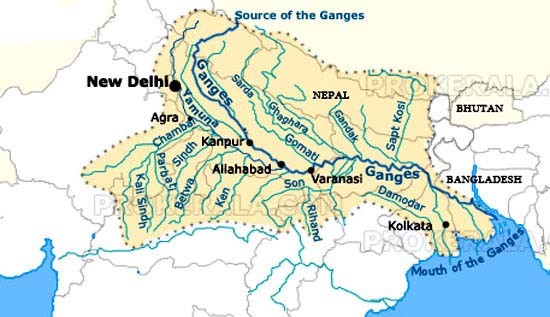Contents
- Centenary Celebrations of Satyajit Ray and Prof. B. B. Lal
- NMCG & NIUA organized IDEAthon
CENTENARY CELEBRATIONS OF SATYAJIT RAY AND PROF. B. B. LAL
Focus: GS-I Art and Culture, Prelims
Why in news?
Ministry of Culture’s Development of Museums and Cultural Spaces (DMCS) digitally launched the short film ‘A Ray of Genius’ to mark the beginning of the centenary celebrations of Satyajit Ray on 2nd May 2020.
On the occasion of centenary year of great archaeologist Professor B. B. Lal, Union Culture Minister released “Prof. B. B. Lal -India Rediscovered” on 2nd May 2020.
Satyajit Ray
- Satyajit Ray was an Indian filmmaker, screenwriter, music composer, graphic artist, lyricist and author, widely regarded as one of the greatest filmmakers of all time.
- The Government of India honored him with the Bharat Ratna, its highest civilian award, in 1992.
- He was awarded an honorary degree by Oxford University.
- Ray’s first film, Pather Panchali (1955), won eleven international prizes, including the inaugural Best Human Document award at the 1956 Cannes Film Festival.
Prof. B. B. Lal
- Prof. B. B. Lal is a precious gem of Indian archaeology who rediscovered the civilizational India buried under the colonial past.
- Prof. B. B. Lal was conferred upon Padma Bhushan in the year of 2000.
- He was the Director General of the Archaeological Survey of India (ASI) from 1968 to 1972.
- Prof. Lal excavated several important landmark sites including Hastinapura (U.P.), Sisupalgarh (Orissa), Purana Qila (Delhi), Kalibangan (Rajasthan).
- From 1975-76 onwards, Prof. Lal investigated sites like Ayodhya, Bharadvaja Ashrama, Sringaverapura, Nandigrama and Chitrakoota under the Archaeology of Ramayana Sites.
NMCG & NIUA ORGANIZED IDEATHON
Focus: GS-III Environment and Ecology
Why in news?
The National Mission for Clean Ganga (NMCG) under the Ministry of Jal Shakti and National Institute of Urban Affairs (NIUA) organized an IDEAthon on “The future of River Management’ to explore how the COVID-19 crisis can shape River Management strategies for the future.
The IDEAthon examined how the social angle of rivers can be leveraged on to address other crises.
COVID-19 crisis has thrown up some positive developments:
- One of these is the visible improvement in the natural environment.
- Rivers have become cleaner.
- The air has become fresher.
- There has been a significant drop in GHG emissions.
- Animals and birds are returning to and enjoying their habitats.
- Purely from a river management point of view, in India there has been a noticeable improvement in the water quality of the Ganga and Yamuna in the last few weeks.
- Sighting of the Gangetic Dolphin is more frequent during lockdown in Ganga and its tributaries.
National Mission for Clean Ganga (NMCG)
- National Mission for Clean Ganga (NMCG) was registered as a society on 12th August 2011 under the Societies Registration Act 1860.
- The government had set up the Clean Ganga Fund in 2014 – Using the funded money to finance NMCG (National Mission for Clean Ganga 2011), cleaning the river, setting up Waste Treatment Plants, Conservation of river biodiversity and related R&D projects.
- In October 2016, National Ganga Council has replaced National Ganga River Basin Authority(NGRBA) which was constituted under the provisions of the Environment (Protection) Act (EPA), 1986.
- NMCG is the implementation wing of National Council for Rejuvenation, Protection and Management of River Ganga (referred as National Ganga Council).
- The NMCG now has the status of an Authority and its key focus would be maintaining required ecological flows in the Ganga, abate pollution through planning, financing and execution of programmes including that of –
- Augmentation of Sewerage Infrastructure
- Catchment Area Treatment
- Protection of Floodplains
- Creating Public Awareness
- The Union Cabinet has recently approved changes allowing the National Mission for Clean Ganga to fine those responsible for polluting the river, which was vested solely with the Central Pollution Control Board earlier. The power to fine the polluters is derived from the Environment Protection Act.
- It has a two-tier management structure and comprises of Governing Council and Executive Committee, both of the tiers are headed by the Director General (DG), NMCG.
- Similar to structure at national level, State Programme Management Groups (SPMGs) acts as implementing arm of State Ganga Committees. This structure attempts to bring all stakeholders on one platform to take a holistic approach towards the task of Ganga cleaning and rejuvenation.
Ganga River System
- The Ganga river system outspreads in India, Tibet (China), Nepal and Bangladesh.
- It is the largest river basin in India and accounts for about one-fourth of the total area of the country.
- It covers states of Uttar Pradesh, Madhya Pradesh, Rajasthan, Bihar, West Bengal, Uttarakhand, Jharkhand, Haryana, Chhattisgarh, Himachal Pradesh and Union Territory of Delhi.

- The river basin is bounded by the Himalayas on the north, by the Aravalli on the west, by the Vindhyas and Chhotanagpur plateau on the south and by the Brahmaputra Ridge on the East.
- The Ganga rises from the Gangotri glacier near Gomukh in Uttarkashi district of the state of Uttarakhand.
- The Ganga river drains into the Bay of Bengal before forming a very huge delta.





